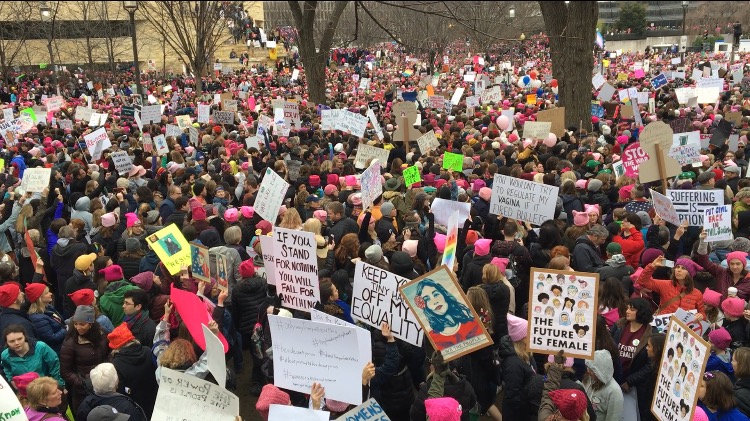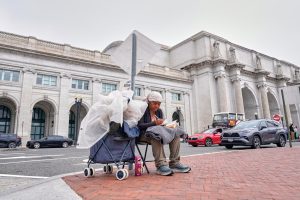New Orleans to DC for Womens March
Hundreds of thousands of protesters were gridlocked in the National Mall for a few hours before finally being able to move forward. The Women’s March on Washington occurred the day after President Trump’s inauguration (Photo taken on Jan. 21, 2017). Photo credit: Dannielle Garcia
January 26, 2017
As Kate O’Leary, biology senior, stepped into the National Mall, she immediately felt the energy of hundreds of thousands of protesters.
“These are our needs, our necessities and we deserve to be treated equally as women and so we are really trying to be heard and show how important this is to us and we will not go quietly,” O’Leary said.
The sea of protesters came together for the Women’s March on Washington on Saturday, Jan. 21, the day after President Trump’s inauguration.
Although the march was for women, it brought together people of all genders, races and religions under one common goal.
The mission of the Women’s March stated, “We join in diversity to show our presence in numbers too great to ignore. The Women’s March on Washington will send a bold message to our new government on their first day in office, and to the world that women’s rights are human rights. We stand together, recognizing that defending the most marginalized among us is defending all of us.”
Women's March on Washington from Loyola Maroon on Vimeo.
As the marchers poured into the streets, they chanted statements like, “we will not go away, welcome to your first day,“ in protest of Donald Trump’s rhetoric during the past election cycle.
O’Leary, along with five other Loyola women, drove overnight from New Orleans to Washington DC, 1,088 miles, to represent the university and stand up for what they saw as a social justice issue.
“It took something as extreme as the president’s inauguration to become this vocal, and what we’re advocating for is nonviolence and equal rights and for a less violent approach for everything, including how you tweet on Twitter and how you talk about women,”
O’Leary said.
With the help of Daniela Marx, head of Loyola’s graphic design department, the group prepared for the march with signs reading “Hate won’t make us great” and “Peace, Love & Nasty Women.” They created sweaters with the word “feminist” across the chest and put on their most comfortable shoes to participate in the march from 8 a.m. to
5 p.m.
Natalie Hatton, an exchange student from London with a dual citizenship in America, was also among the Loyola women who attended.
“This is not just an American issue but a worldwide issue,” Hatton said. “There is an innate sense of sisterhood between women… to be among so many who share a passion for the same thing I do is unbelievably empowering. I can no longer stay silent, I owe it to these women and to myself to stand up and speak out, not just now but until real change is enacted,” Hatton said.
Tim Jorgensen, a professor at Georgetown University, was one of the many male participants present.
“I think Trump and his rhetoric are a threat to all groups that have vulnerabilities. I see this as a positive demonstration for women, but obviously the underlying tone is an opposition to Trump,” Jorgensen said.
As the day progressed, it was clear that the protest organizers underestimated the number of people that would come to the event and the power of the movement.
According to the Associated Press, with over 500,000 protesters in Washington DC, the participants were gridlocked and had to find an alternate route in order to begin the forward movement.
“Regardless of your politics, the magnitude of this event says something,” Hatton said.
Athena Merida, sociology freshman, participated in the movement that took place in New Orleans.
“It was important for me to go for myself and in honor of my grandparents who came from a different country for a better life, and they are the reasons that America is great to me,” Merida said.
President Trump’s first reaction to the global protests was communicated at 7:51 Saturday a.m. via his personal Twitter.
“Watched protests yesterday but was under the impression that we just had an election! Why didn’t these people vote? Celebs hurt cause badly.”
A few hours later he remarked again, “Peaceful protests are a hallmark of our democracy. Even if I don’t always agree, I recognize the rights of people to express their views.”
According to the Associated Press, the March set the record for the largest protest in American history, with marches in every US state, all seven continents — even Antarctica — 60 countries and over 670 locations with more than 3 million participants worldwide.
Anne Singer, English writing senior, attended the march with the group in Washington DC and hopes that the fight for equality does not end there.
“I think the most important thing we can do after the march is work at educating others and calling your senators’ offices to see change at a local level, and without a commitment to this action, our march would be for nothing,” Singer said.







